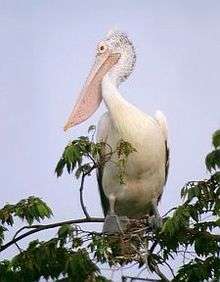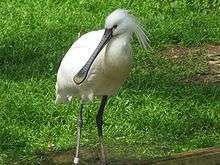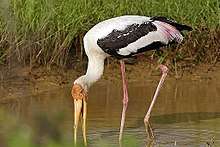Protected areas of Tamil Nadu
The Protected areas of Tamil Nadu State in South India cover an area of 3,305 km2 (1,276 sq mi), constituting 2.54% of the geographic area and 15% of the 22,643 km2 (8,743 sq mi) recorded forest area. It ranks 14th among all the States and Union Territories of India in terms of total protected area.[1]
Creation and administration of Protected areas in South India originated with the Maharajas of the Southern Princely States' private hunting grounds. The Mudumalai National Park, established in 1940, was the first modern Wildlife Sanctuary in South India. Most protected areas throughout its 30 Districts are under the stewardship of the Ministry of Environment and Forests (India) and the Tamil Nadu Forest Department.
| Map Key: |
Biosphere Reserve |
National Park |
Wildlife Sanctuary |
Bird Sanctuary |
Zoo |
|---|
Biosphere reserves
The three Biosphere Reserves in Tamil Nadu are:[3]
- Gulf of Mannar Biosphere Reserve: 10,500 km2 (4,100 sq mi); established in 1989.
- Nilgiri Biosphere Reserve: 5,520 km2 (2,130 sq mi), of which 2537.6 km² is in Tamil Nadu. Established in 1986.
- Agasthyamalai Biosphere Reserve: 3,500.36 km2 (1,351.50 sq mi); established in 2001.[3]
of Tamil Nadu
Tamil Nadu has five National Parks covering 307.84 km2 (118.86 sq mi).[3]
- Anamalai Tiger Reserve (formerly Aanamalai National Park, Indira Gandhi National Park): 117.10 km2 (45.21 sq mi); established 1989.
- Mudumalai National Park: 103.24 km2 (39.86 sq mi); established 1990.
- Mukurthi National Park: 78.46 km2 (30.29 sq mi); established 1982.
- Gulf of Mannar Marine National Park: 6.23 km2 (2.41 sq mi); established 1980.
- Guindy National Park: 2.82 km2 (1.09 sq mi); established 1976.
- Palani Hills Wildlife Sanctuary and National Park (proposed)[3]
Wildlife sanctuaries
Tamil Nadu has the following wildlife sanctuaries:[3]
- Grizzled Squirrel Wildlife Sanctuary: 485 km2 (187 sq mi); giant squirrel sanctuary near Srivilliputhur
- Anamalai Tiger Reserve
- Kalakkad Mundanthurai Tiger Reserve: 223.58 km2 (86.32 sq mi)
- Kanyakumari Wildlife Sanctuary: 457.78 km2 (176.75 sq mi)
- Mudumalai Wildlife Sanctuary: 217.76 km2 (84.08 sq mi); overlaps with Mudumalai National Park
- Sathyamangalam Wildlife Sanctuary: 1,411.6 km2 (545.0 sq mi)
- Vallanadu Wildlife Sanctuary: 16.41 km2 (6.34 sq mi)
- Point Calimere Wildlife and Bird Sanctuary
- Megamalai Wildlife Sanctuary
- Point Calimere Wildlife Sanctuary
- Kodaikanal Wildlife Sanctuary
- Gangaikondan Spotted Deer Sanctuary
- Cauvery North Wildlife sanctuary
- Nellai Wildlife Sanctuary[3]
Elephant reserves
Tamil Nadu participates in Project Elephant, and has five elephant sanctuaries.
- Nilgiri Elephant Reserve: 4,663 km2 (1,800 sq mi), protected area 716 km2 (276 sq mi); established 2003.
- Coimbatore Elephant Reserve: 566 km2 (219 sq mi), protected area 482 km2 (186 sq mi); established 2003.
- Anamalai Elephant Reserve 1,457 km2 (563 sq mi), protected area 300 km2 (120 sq mi); established 2003.
- Srivilliputtur Elephant Reserve, 1,249 km2 (482 sq mi), protected area 568 km2 (219 sq mi); established 2002.
Tiger reserves
Though The 2008 census indicated a decline in tiger population all over India, the only exception was in Tamil Nadu where the animals' numbers have increased to 76 from 60 five years ago.[4][5] Tamil Nadu participates in Project Tiger and has four tiger reserves:
- Kalakkad Mundanthurai Tiger Reserve: 900 km2 (350 sq mi); part of Agasthyamala Biosphere Reserve.
- Mudumalai National Park was declared a tiger reserve in April 2007. Subsequently, about 350 families living in the core area have been evicted from the park and given 1 million rupee ($20,800) compensation. Those in the 5 km buffer area around the park will be involved in the project as trackers and guides to enhance their income through eco-tourism.[6]
- Anamalai Tiger Reserve: declared a Tiger Reserve in 2008.[7]
- Sathyamangalam Wildlife Sanctuary was declared a tiger reserve in 2011.
Bird sanctuaries
- Chitrangudi Bird Sanctuary: .48 km2 (0.19 sq mi)
- Kanjirankulam Bird Sanctuary: 1.04 km2 (0.40 sq mi)
- Karaivetti Bird Sanctuary: 4.54 km2 (1.75 sq mi)
- Karikili Bird Sanctuary
- Koothankulam Bird Sanctuary: 1.2933 km2 (0.4993 sq mi)
- Melaselvanur – Kilaselvanur Bird Sanctuary: 5.93 km2 (2.29 sq mi).[8]
- Point Calimere Wildlife and Bird Sanctuary: 17.26 km2 (6.66 sq mi)
- Pulicat Lake Bird Sanctuary: 461.02 km2 (178.00 sq mi)
- Udayamarthandapuram Bird Sanctuary: .45 km2 (0.17 sq mi)
- Vaduvoor Bird Sanctuary: 1.28 km2 (0.49 sq mi)
- Vedanthangal Bird Sanctuary: .3 km2 (0.12 sq mi)
- Vellode Birds Sanctuary: .772 km2 (0.298 sq mi)
- Vettangudi Bird Sanctuary: .344 km2 (0.133 sq mi)
- Viralimalai Peacock Sanctuary]][9]
- Kallaperambur Lake near Thanjavur
- Suchindram Theroor Birds Sanctuary
Conservation reserves and community reserves
Zoos
Two zoos in Tamil Nadu are recognised by the Central Zoo Authority of India. The state has many other smaller zoos as well.
- Arignar Anna Zoological Park: 5.10 km2 (1.97 sq mi)
- Madras Crocodile Bank Trust[10]
Crocodile farms
Tamil Nadu five crocodile farms:
- Amaravati Sagar Crocodile Farm, Coimbatore district
- Hogenakkal Crocodile Bank, Dharmapuri district
- Kurumbapatti Crocodile farm, Salem district
- Madras Crocodile Bank Trust, Chennai
- Sathanur Dam Crocodile Bank, Tiruvannamalai district
Regional cooperation
Senior forestry officials cooperate on mutual issues concerning conservation and protection of forests and wildlife of the region. A regular conference of the forest ministers and forest officials of the southern states is held once a year, in rotation in each State. The Forest Ministers of Kerala, Tamil Nadu, Andhra Pradesh and Karnataka, senior officials of the Ministry of Environment and Forests, Government of India, Forest Secretaries of Tamil Nadu and Kerala, Special Secretary for Forests, Andhra Pradesh, Principal Chief Conservator of Forests of Kerala, Tamil Nadu, Andhra Pradesh and Karnataka, together with the senior forest officials of these states and the Union Territory of Pondicherry, met at Thiruvananthapuram on November 3 and 4, 2006 and resolved several mutual issues concerning conservation and protection of forests and wildlife of the region. This formalization of interstate cooperation on protected areas administration improves effectiveness in the areas of: daily staff communication including common wireless frequencies, joint enforcement action, boundary survey and demarcation, management of cross border resources like Biosphere Reserves, National Parks, Tiger reserves and Wildlife Sanctuaries, technology, staff and intelligence sharing and coordinated communication with the Government of India, especially allotting more funds for conservation and forestation activities of State Forest Departments by the Union Government.[11] The second meeting was held at Bangalore on September 21 and 22, 2007.[12] The third meeting was held at Hyderabad on October 25 and 26, 2008.[13]
References
- ↑ Tamil Nadu Forest Dept. Wild Biodiversity Archived 2012-02-06 at the Wayback Machine.
- ↑ Tamil Nadu Forest Dept.Eco-Tourism Archived 2017-04-21 at the Wayback Machine.
- 1 2 3 4 5 6 "Bio-Diversity and Wild Life in Tamil Nadu". ENVIS Centre. Retrieved 15 March 2018.
- ↑ "India tiger population declines". South Asia. BBC News. 2008-02-13. Retrieved 25 November 2009.
- ↑ Qamar Qureshi; K. Sankar; Rajesh Gopal; Y.V. Jhala (2008). "Western Ghats Landscape Complex/Tamil Nadu". Status of Tigers, Co-Predators and Prey in India (PDF). National Tiger Conservation Authority, Ministry of Environment & Forests, New Delhi and Wildlife Institute of India, Dehradun. pp. 72–94. Archived from the original (PDF) on 2013-06-02.
- ↑ Murari, S. (31 December 2008). "Thousands Protest Against Indian Tiger Reserve". Planet Ark. Reuters. Archived from the original on 16 July 2011. Retrieved 2009-10-30.
- ↑ "Eight New Tiger Reserves". Press Release. Ministry of Environment and Forests, Press Information Bureau, Govt. of India. November 13, 2008. Retrieved 2009-10-31.
- ↑ Migratory birds flock to Vettangudi Sanctuary, The Hindu, 9/11/2005, Hinduonnet.com, Vettangudi
- ↑ Rural Development and Panchayat Raj (PR.2) Department, G.O. (Ms) No.19, Dated: 23.1.2008 TNRD.gov.in, Declaring Viralimalai as a heritage place
- ↑ Tamil Nadu Forest Dept. Zoos Archived 2011-07-21 at the Wayback Machine.
- ↑ Conference of the Forst Ministers of Southern States, Thiruvananthapuram, 3 – 4 November 2006 Resolution
- ↑ Two-day meet of Forest Ministers concludes
- ↑ "Southern Forest Ministers' meet for tax on forest produce". The Hindu. Chennai, India: Kasturi & Sons Ltd. 2008-10-27. Retrieved 17 April 2010.









